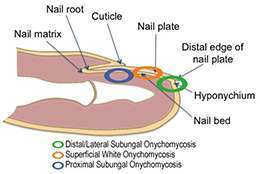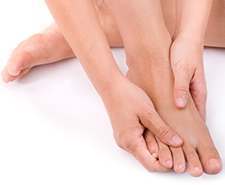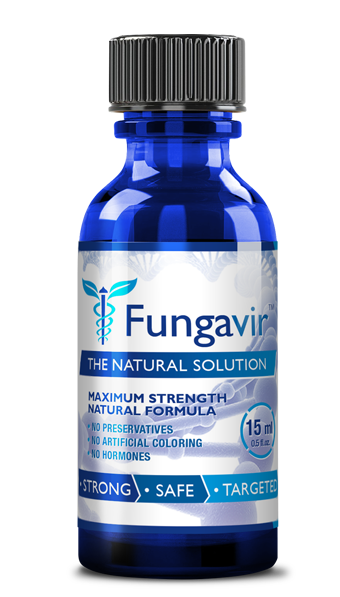What is Nail Fungus?

Did you know that over 50 million people have nail fungus? It is a common infection, known by a few names, and with a few causes. Often, it is called Onychomycosis (tinea unguium) or nail ringworm.1 It can be found on finger nails as well as toenails. It tends to grow and further infect a person's nails when the hands or feet are in warm, moist and confined places, like shoes or gloves. Yes, shoes are the ideal breeding place for nail fungus because of the combination of moisture, high temperature heat and darkness. It often starts with a small white or yellow discoloration which you see beneath the tip of your toenail or fingernail. Soon, it spreads and the whole nail becomes yellow, brown or even black and it may spread to other nails as well. Your nails often becomes thick and show signs of cracking or crumbling edges. Beneath the nail bed of your fingers or toes the fungal infection breeds and grows. Often, people complain that there is associated pain in addition to looking unpleasant. And, in addition to spreading to other nails, it can also spread and infect other people.
What are the Causes and Characteristics of Nail Fungus?
Because nail fungus or Onychomycosis is infectious, many people pick it up from others in locker rooms, public showers and pools or from family members. But you can get it even if you never go into a locker room. Your shoes and socks keep your feet warm and moist, and fungal infections can easily grow there. Early signs of cracked or discolored nails should be carefully monitored. Athlete's foot can spread to other areas and can grow into the nail bed. As we get older, our bodies are able to pick up all kinds of infections easier, and nail fungus is no exception.

A manicure or pedicure in a salon is often a place where one picks up an infection. If the salon does not sanitize or even sterilize their equipment, they will spread the infection like a rapid fire. When they use equipment that is not cleaned properly or not sterile, the salon will spread the fungus from one person to another, and to both finger and toe nails. In addition, many women get fungal infections when acrylic nails are not removed and moisture accumulates under the nail. People who work with their hands in water or rubber gloves for extended periods of time are also susceptible to nail fungus. This job hazard is a real problem for many people. Of course, people who work with their feet in water or heavy work boots have the same problem.
There are 3 common kinds of nail fungus, the most common is caused by a dermatophyte fungus.2 In this form of fungus, the infection gets into the space between the toe or finger and the nail edges or the skin on the edges. First, the nail becomes yellow and in severe cases, the nail can separate from the lower nail bed. This is more common in toenails where the nail may get brittle and can fall off . It usually becomes a darker brown or even black color.
Nail fungus can also be the result of a yeast infection, Candida Albicans. This type of infection is the common kind on fingernails. Usually, the yeast infection type of nail fungus causes the finger nail to have a yellow or green or foggy look to it. This kind of Nail Fungus is more common in fingernails when the hands have to be in water a lot of the time. A yeast infection can set into a crack or cut in the nail of under the nail bed. People who work in heavy boots, or who wear tennis shoes all the time, or sweat a great deal, may get this kind of nail fungus on their toes.
Some people get a nail fungus caused by mold, although it is less common. When someone walks barefoot outside, there is a chance, although minute, of catching a mold infection on the feet which can spread to the toenails. This kind of fungus may enter the nail through a crack or jagged edge in the nail or a cut in the toenail.
How Can You Prevent Nail Fungus?

If you can prevent nail fungus from occurring, you are of course better off than trying to heal the infection once it starts. The following are some prevention ideas to keep you as safe as possible:
Change shoes and socks whenever they get wet or sweaty. Wear open shoes or sandals, if you can, or go without shoes (at home) if possible. Use some foot powder in your socks and shoes to keep your feet dry. Keep your feet dry after they sweat. Change your socks and shoes if you are involved in any sports or exercise. Wear sandals or flip flops in locker rooms, pool areas or public showers areas. For a manicure or pedicure always bring your own tools. Do not allow them to use equipment or tools that have been used on other clients. Never put your hands or feet into basins used by others unless you are sure it has been sterilized not just washed. Make sure that the shoes you wear are not too tight for your feet. If you have to wear gloves, take them off as often as possible.
Why use Fungavir™ Instead of Prescription Nail Fungus Treatments?
Usually, doctors recommend very strong medication that you swallow. These contain high doses of antifungal drugs that can and will adversely affect your body. While working to clear the fungal infection, they are also working on your liver, bone marrow and other internal organs. It is not always safe to ingest antifungal medications into your body. In order to be effective, you would need to take these pills for 4 to 6 months and at the same you are exposing your liver, bone marrow, stomach , intestines and skin to very strong medication. There are many side effects, which is why the doctor will order a blood test once a month. And if you are taking other medications you should tell your doctor. You could be at risk if you have liver, heart, stomach or many other medical complications. These medications often cause diarrhea, stomach pain, and even vomiting. The signs may be discoloration or light feces, blood in the stool, and other ailments. Many people complain of skin rashes that do not go away or of itching, hives or welts. Other side effects like dark urine, pale stools, throat pain have been experienced. If you decide to take a prescription antifungal medication, make sure your doctor performs monthly blood tests during the treatment.

Fungavir™ is a different kind of treatment. You do not swallow it, but put it directly on the toenail or fingernail. Fungavir™ is a safe topical treatment made of all natural ingredients. It does not go into the body to cause damage to any organs. It is very effective, and it works well on all kind of nail fungus. For more information on the benefits of Fungavir™ click here.







 Fungavir™'s formulation of effective ingredients and strong name recognition have brought praise from both customers and health professionals alike. To learn more about the research and data behind Fungavir™ , please visit our "
Fungavir™'s formulation of effective ingredients and strong name recognition have brought praise from both customers and health professionals alike. To learn more about the research and data behind Fungavir™ , please visit our "




